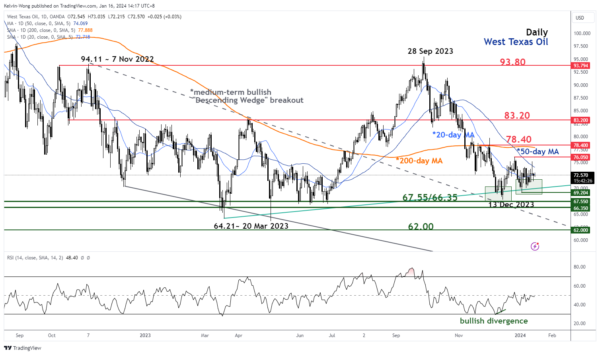- Ongoing hostilities in the Middle East region and the Red Sea shipping route have put a potential “floor” in oil prices due to the increasing risk of supply disruptions.
- The demand side has remained weak as China’s top policymakers have signalled a less forceful approach in enacting stimulus measures after PBoC left its 1-year MLF rate unchanged at 2.50%.
- Sideways for now between US$76.05/78.40 and US$69.20 for WTI crude oil.
Since our last report, the price actions of West Texas Oil (a proxy of WTI crude oil futures) have managed to trade above its 13 December 2023 low of US$67.82/barrel and whipsawed around the 20-day moving average in the past two weeks.
Conflicting fundamental factors
There are no clear catalysts to determine whether the bulls or bears are leading the oil market as conflicting factors are at play, thus causing a flux situation at this juncture.
On the positive side that is supporting oil prices is the rising geopolitical risk premium in the Middle East region that could potentially disrupt the oil supplies. The odds are high for an increase in hostilities in the Red Sea shipping route where Yemen’s Houthi militants are showing no signs of backing down in attacking registered ships from Israel and its allies, primarily the US in the Red Sea despite the recent joint counter strikes from US and UK to neutralize these threats.
In addition, Iran, a key stakeholder in the Middle East has started to play a bigger military role in terms of showing its displeasure in the ongoing war between Israel and Hamas by mounting an attack yesterday on Israel’s spy HQ in Iraq as reported by various media outlets.
On the flipside, the demand side narrative for oil remains weak as China’s central bank, PBoC has disappointed market participants by keeping one of its key benchmark interest rates unchanged; the 1-year medium-term lending (MLF) rate was held at 2.5% since August 2023.
This latest monetary policy move from PBoC has signalled that Chinese top policymakers are in no rush to enact more “pronounced” stimulus measures to negate the deflationary risk spiral in China, thus dampening the mood of short-term bullish animal spirits in the oil market.
Potential minor bottoming for WTI crude
Fig 1: West Texas Oil medium-term trend as of 16 Jan 2024 (Source: TradingView, click to enlarge chart)
In the lens of technical analysis, the recent steep drop of -15% of WTI crude from 30 November 2023 to 13 December 2023 has managed to stall at the medium-term ascending trendline support in place since the 20 March 2023 swing low of US$64.21. In addition, it has formed a “higher low” in the past four weeks.
The key resistance of this potential minor bottoming formation stands at US$76.05/78.40 which confluences with 50-day and 200-day moving averages that are acting as price caps as well.
Therefore, in the short to medium term, WTI crude is likely to trade sideways between US$78.40 and US$69.20 (the ascending trendline from the 20 March 2023 low) due to conflicting fundamental factors. Only a clearance above US$78.40 may ignite a more impulsive upmove sequence to see the next medium-term resistances coming in at US$83.20 and US$93.80.
On the other hand, failure to hold at US$69.20 sees a slide to retest the first major support zone at US$67.55/66.35.















